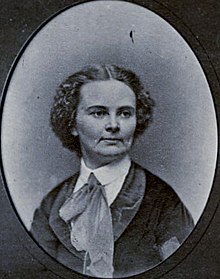Harriet Hosmer
| Harriet Hosmer | |
|---|---|
 |
|
| Born |
October 9, 1830 Watertown, Massachusetts |
| Died | February 21, 1908 (aged 77) Watertown, Massachusetts |
| Nationality | American |
| Known for | Sculpture |
| Movement | Neoclassicism |
| Signature | |
Harriet Goodhue Hosmer (October 9, 1830 – February 21, 1908) was a neoclassical sculptor, considered the most distinguished female sculptor in America during the 19th century. Among other technical innovations, she pioneered a process for turning limestone into marble. Hosmer once lived in an expatriate colony in Rome, befriending many prominent writers and artists.
Harriet Hosmer was born on October 9, 1830 at Watertown, Massachusetts, and completed a course of study at Sedgewick School in Lenox, Massachusetts. She was a delicate child, and was encouraged by her father, physician Hiram Hosmer, to pursue a course of physical training by which she became expert in rowing, skating, and riding. She traveled alone in the wilderness of the western United States, and visited the Dakota Indians.
She showed an early aptitude for modeling, and studied anatomy with her father. Through the influence of family friend Wayman Crow she attended the anatomical instruction of Dr. Joseph Nash McDowell at the Missouri Medical College (then the medical department of the state university). She then studied in Boston and practiced modeling at home until November 1852, when, with her father and her friend Charlotte Cushman, she went to Rome, where from 1853 to 1860 she was the pupil of the Welsh sculptor John Gibson.
When Hosmer knew herself to be a sculptor, she knew also that in America was no school for her. She must leave home, she must live where art could live. She might model her busts in clay of her own soil, but who should follow out in marble the delicate thought which the clay expressed? The workmen of Massachusetts tended the looms, built the railroads, and read the newspapers. The hard-handed men of Italy worked in marble from the designs put before them; one copied the leaves which the sculptor threw into the wreaths around the brows of his heroes; another turned with the tool the folds of the drapery; another wrought up the delicate tissues of the flesh; none of them dreamed of ideas - they were copyists - the very hand-work that her head needed. And to Italy she went...
...
Wikipedia
